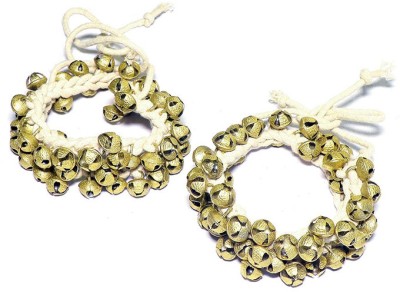Ghungroo World Bharatanatyam, Bharata Muni, Chhau, Kathak, Kathakali, Satriya, Odissi, Mohiniyattam, Manipuri Ghungroo(50 Bells)
Quick Overview
Product Price Comparison
Ghungroo World Bharatnatyam Ghungroo Red Pad 1 Line 2 Line 3 Line 4 Line & 5 Line,Bells of brass tied with premium velvet/cotton/leather cloth. The Ghungroo are sewed/ stitched to the fabric."Ghungroo kathak 25 50 100 anklet bells each red brass thick white cotton string thread velvet for girls dance women kids with belt Bharatanatyam kuchipudi gajjalu adults classical dancing brass loose big leather pad buckel pair salangai chilanka odissi We are engaged in offering an exquisite variety of Ghungroo Bells. Ghungroos is a musical anklet used by performers of all classical dances. Several bells are attached to a string or tied to a cotton cord, and velvet pad strap to form a ghungroo. These bells are made of brass and have small iron balls inside which add quite a lot of weight to them. Ghungroo is a musical anklet tied to the feet of classical Indian dancers. The Ghungroos on a rope are used mainly for Kathak dance. Ghungroo pairs made in brass mounted on colorful cloth/velvet pads/Cotton pads are mainly used for Bharatanatyam, Kuchipudi, and Odissi dance. Depending upon the dancer's age and the size of their ankles, one can choose the size of the ankle bell. SKSM is making a Quality product with the best piece available. We are engaged in the metal business, through which we bring our products friendly to people, including handmade products. we use different metals for different products such as brass, copper, aluminum, and other related products. We are a leading manufacturer of Ghungroo, and Brass Puja articles such as Brass Handle bell, Diya, Temple Bell, Velcro velvet pad, etc.Under this category, you will find many different types of ankle bells for various dance forms. We have ankle bells for the Bharatanatyam dance, Kuchipudi dance, Kathak dance, and belly dance. We have ankle bells / Ghungroos made of leather, cloth, velvet, and rope. The Ghungroos on the rope are used mainly for Kathak dance. The ankle bells with leather or cloth pad are mainly used for Bharatanatyam, Kuchipudi, and Odissi dances.Indian classical dance includes diverse dance forms and a multitude of styles, each significantly different from the other but at the same time sharing many features in common. All eight classical dance forms are primarily region specific, from Manipur in the North East to Kerala in the south, with their distinct rhythm, beauty, costume, music, language, and lyrics, though all are known to have descended from the Natya Shastra and hence borrow heavily from Sanskrit language and literature. Of all the common things, Gunghroo, the ankle bell, is probably the most noticeable and important across all dance forms in India. It is also used in most folk dances of India, sometimes as a piece of the orchestra.Ghungroo, also known as Salangai in Tamil, are small metal bells, mostly made of brass, strung together to form a musical anklet, worn by the dancers be it Bharatanatyam, Kathak, Kuchipudi, Mohiniyattam or Oddisi. For ease of use, these metallic balls are fixed on a leather or cotton/velvet/Velcro strap that can be easily worn around the ankle of the dancer. The sound produced varies depending on the metal and the size of the individual bell. Worn immediately above the ankle, they are more than a piece of jewelry or adornment. Ranging anywhere from 50 to 200 in number on each anklet, ghungroos help to emphasize the rhythmic facet of the particular dance highlighting the complex footwork attempted by the dancers.The ghungroo gains special significance as it is primarily an ornament that differentiates a dancer from a non-dancer and specifically a dancer ready for performance. In the Devdasi tradition, as most classical dances were, this was of crucial importance, and as such appropriate deference was accorded to it. In Bharatnatyam for example, Gejjai puja or Sailanga Puja, the worshipping of the ghungroos is an important ceremony as a precursor to an Arangetram, the debut on stage. An integral part of Indian classical dance Ghungroos accentuates the rhythmic percussion acoustics produced by the complex foot movements of the dancers.Apart from emphasizing the complexity of the foot movements, the sound produced by the ghungroos also keeps the dancer in tune with the music and stays in rhythm by providing a template. Hence we can say that Ghungroos is almost like a badge for dancers helping them highlight their skills while being decorative and functional at the same time.


